

|
|
|
|
|---|---|---|
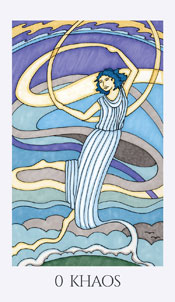





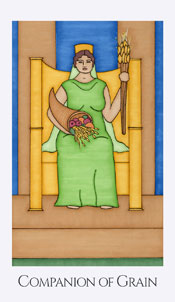
|
I’ve been a fan of Ellen Lorenzi-Prince’s tarot decks since her very first,
Tarot of the Crone,
but the Greek Goddess Tarot takes my love to a whole other level. This is partially due to the fact that I am familiar with the Greek Goddess mythology and am particularly attached to
Artemis
and
Athene.
At least equally importantly,
my passion is story and tarot
and connecting the two, and each card in this deck combines story with interpretation, making the cards easier to connect with for the reader and more memorable and resonant for querents in a reading.
While Lorenzi-Prince’s 78-card deck, the Dark Goddess Tarot did that to some degree, for some reason, this deck does it in a way that is more tangible and helpful to me. In addition, I’ve had a lot of magical readings with it already, a particular connection that I’ve rarely had with any deck but my own. As Goddess Martha Reeves sings, “Can’t explain it, don’t understand it, I ain’t never been like this before.” But every reading has been profound; there’s nothing shallow or obfuscatory about my response to these cards, and my querents have echoed this potency and depth. The Major Arcana are based on “the most ancient ones,” the primordial goddesses/elementals who preceded even Zeus and the Olympians. I was not familiar with all of them, but Hekate, Rhea, Mnemosyne, Metis, Themis and the Moirai are fairly recognizable even to those not expert in Greek mythology. Certainly, Gaia is—and anyone who has long been a part of the Tarot community knows the name Thalassa, if not her stories and characteristics. Lorenzi-Prince is steeped in these myths and their history, but she is equally infused with tarot understanding, so her matches to the cards are penetrating and filled with wisdom. They pack a punch—a punch made with Everclear at its highest percentage. (Yes, that’s a clarity pun.) Pick a card, any card, and I’ll show you what I mean. Let’s start with the traditional Fool card, Khaos, Goddess of Beginning (that’s a very good place to start). Our usual thoughts about the Fool are, in addition to beginnings, about risk and leaps of faith, and the chaos that often follows. Khaos is the progenitor of the elementals of air and mist (and Uranus rules the Fool and the air sign Aquarius), Nyx (Night) and Hemera (Day). The directive to “Breathe fresh air” is embodied by this card, which is excitingly and evocatively drawn. It’s almost as if you enter its (Her?) whirlwind. The Emperor is always a tricky card to capture in a Goddess-themed deck, because the archetype is so traditionally masculine, with all that implies. And Metis has Her own connection with Zeus, who placed Metis in his belly so she could think for him “for good and evil.” (Hesiod, Theogony). Her gifts are macrocosmically strategic: “planning, forethought, counsel, and cunning.” Athene is her daughter, and Metis creates the armor and weapons Athene uses to spring from Zeus’ brow in order to escape his body and enter the world. I love the power over the mundane that Metis’ efforts accomplish. They perfectly mesh masculine/feminine energies. Even when one of these Ancient Ones is unfamiliar, they foreshadow and even echo ones with which we are more familiar. In the Greek Goddess Tarot, Ankhiale, Goddess of Warming Fire shares a symbology with Brigid at the forge. And who but the Moirai, the Goddesses of Fate, fit the Wheel of Fortune card better? The Wheel is often interpreted simply as good fortune for the future, and sometimes incorporates The Wheel of the Year and seasonal shifts. But this version of the card is so much deeper. To quote Lorenzi-Prince’s booklet: “The Moirai are the Titan Goddesses of Fate. The Spinner, the Apportioner of Lots, and She Who Cannot Be Turned work together to assign each person’s portion for their journey from birth to death. With each share comes a special destiny. Yet the assignment is not absolute. The Moirai provide the framework of one’s life. They do not spell it out step by step.” “Meaning: When things feel meant to be, it’s not about your life being written in stone or in the stars. It’s about you recognizing the path of your destiny. That which was born within you is revealing itself and drawing you toward your fate’s fulfillment.” Isn’t that a lot deeper a take on this card than most tarot texts provide? Thalassa, Goddess of the Sea, is featured on the Hanged One card. So tempestuous, which seems fitting in comparison to the more typically static versions of this card. When you’re turned upside-down, you roil before the waves calm. The Moon and Sun are the Elemental Nyx (Goddess of the Night) and Protogenos Hemera (Goddess of the Day), respectively. While that may seem facile on the surface, the pairing reminds us of the elemental (and Elemental) nature of these two cards: “ . . . [W]here Nyx and Hemera draw near and greet one another as they pass the great threshold of bronze . . . and the house never holds them both within, but always one is without the house passing over the earth, while the other stays at home and waits until the time for her journeying come; and the one holds all-seeing light for them on earth.” (Hesiod, Theogony) The Goddesses of the Minor Arcana are more well-known and will make sense to even the most casual fan of the Greek pantheon: Arrows (Wands) are attributed to Artemis (a real firecracker, She), Cups, Aphrodite, Goddess of Love, Brilliant Warrior Goddess Athene rules Swords, and Demeter’s domain is Grain (Pentacles). You can see how perfectly these Goddesses mesh with their suits. The Two and Three of Wands are not the most active of their Yang suit in traditional tarot, but Lorenzi-Prince’s choice of fables for these cards are based on text that perfectly matches my understanding of each of them. The Two of Arrows depicts Artemis assessing the lands she intends to claim, no matter how vast: "And give to me all mountains; and for city, assign me any, even whatsoever thou wilt: for seldom is it that Artemis goes down to the town. On the mountains will I dwell." (Callimachus, Hymn to Artemis) Lorenzi-Prince’s interpretation expands the traditional take on this card as much as Artemis expands her own horizons: “Take a wider view, a higher view, before deciding on a course. Set your sights high. Imagine great possibilities. Do not fix on only one road. Go where there are no roads, where every step you make leads to more freedom and sovereignty.” The Three of Arrows is a little further up the metaphoric mountain—young and precocious Artemis “captures deer large as bulls and yokes them to her chariot” (Callimachus, Hymn to Artemis). She is beginning to take the actions that will ease her journey following the vision of the Two. With each of these suits, we get to know more than the most popular myths about each of the four goddesses, we go “behind the scenes” to their purest, most historical/legendary essence. We all know how bewitching the “sex goddess” Aphrodite can be, but we also see her tender, maternal side in the Six of Cups. One of my favorite Swords cards is the Eight. The image is of a self-immobilized Arachne, who hangs herself in shame on her own loom after challenging and losing to Athene in a weaving contest. The implacable, but not totally unmerciful Athene magically transitions Arachne into the joys of spiderhood. I am particularly gratified by Demeter in this deck. As ruler of the suit of Grains, She is not a nubile young Goddess, but a more mature symbol of power. You can especially see this in the Court Cards, which are renamed thus: 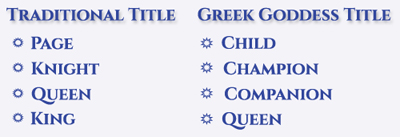
I love the switch from King to Queen, but it may take a bit of adjustment to remember that the King is the Queen. I actually love all the renamings, as they suit my understanding of the essence of each Court. While I would recommend this deck even to tarot novices because of the power of story to enhance memory and connection, I can see it being a must-buy for pagans/worshipers of the Goddess, especially those who are linked to the Greek pantheon. I truly love this deck, and the way it enriches my readings, adding magic and depth with its ancient wisdom.
|

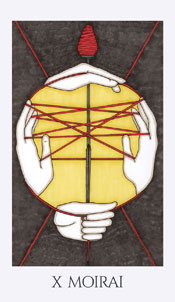
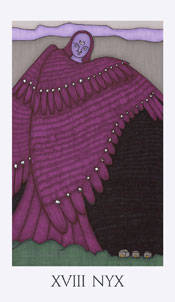
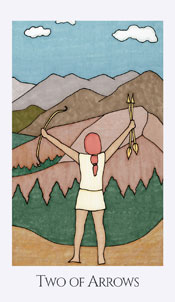
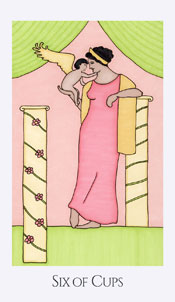
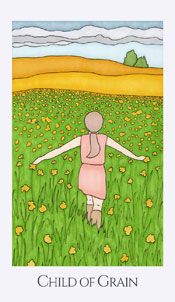

|
|
|
Greek Goddess Tarot is copyright protected. Card images may be used on blogs/websites as 'Card of the Day' endeavors or for reviews but must contain the website along with Greek Goddess Tarot by Ellen Lorenzi-Prince. The images are not to form part of written teaching materials or otherwise be used without prior consent from the artist. | |
|
|
Home · Tarot of the Crone · Dark Goddess Tarot · Minoan Tarot · Arts & Artifacts · Contact | |
|
This site designed & maintained by Arnell's Art |